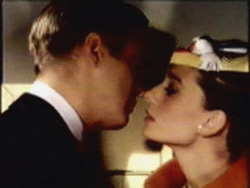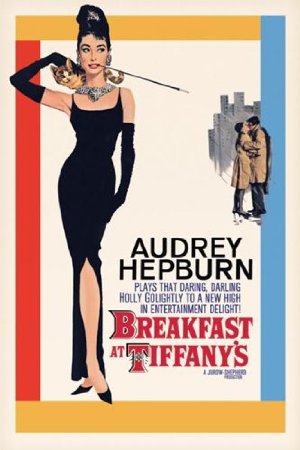Breakfast At Tiffany's Review
By Don Willmott

Set in present-day 1961 (as opposed to during World War II as in the novel), the film introduces us to the gorgeous Holly Golightly (a sparkling Audrey Hepburn) as she staggers home early one morning in her little black dress and sunglasses after yet another all-night bender during which she likely doled out small favors to amorous older gentlemen in exchange for rent money. Pausing in front of Tiffany's, Holly munches a danish and sips coffee as she admires the jewelry in the window. It's an iconic movie moment. Holly sees herself as a free-spirit, a party girl, someone who, as she puts it, won't be caged by love or commitments. It's a lonely life, but it pays the bills. The'60s are on the verge of swinging.
Holly has an apartment in an Upper East Side townhouse as does Japanese photographer Mr. Yunioshi (Mickey Rooney, in an appallingly stereotyped ching-chang-chong performance that should be eliminated from the history of cinema) and dashing aspiring writer Paul Varjak (George Peppard), who is sort of gay in the novel but quite straight here. Paul is fascinated by Holly; she finds him charming enough to invite him to one of the wild parties she throws in her apartment, where various types of out-of-town businessmen, dirty old men, and Eurotrash gather to swill booze and cackle with each other. Holly seems to have a hand in each one of their pockets. Her cat, named Cat, a major character in his own right, watches all this with disdain.
Capote has no interest in telling a typical boy-meets-girl love story. The relationship between Holly and Paul, whom she calls Fred in honor of her brother, evolves in unusual ways, especially as we learn that Fred is guilty of the same kind of shady behavior that he finds so unattractive in Holly. (Patricia Neal is elegantly terrifying as a conniving interior decorator whose pocketbook is never far from Paul's pant leg.)
But who is Holly anyway? Where has she come from? Why, Paul wonders, does she travel to Sing Sing prison on a weekly basis to visit a jailed mobster? She's not the type to dwell on unpleasantries, but the second half of the movie finds Paul unraveling her many mysteries with the help of a surprising out-of-town visitor (Buddy Ebsen) who knows much more about Holly's past than she would like to make public.
Breakfast at Tiffany's is packed with wonderful dialogue and unforgettable moments, including a hilarious shoplifting scene and, of course, the transcendent moment when the beautiful Hepburn sings "Moon River" on her fire escape. (Henry Mancini was commissioned to come up with a song that would fit within Hepburn's very narrow vocal range. Anyone can hit all the notes. Try it.) Whether or not Holly and Paul end up together is ultimately less important than whether they can forgive each other -- and themselves -- for the many errors of their ways. Capote's New York is not a place where redemption comes easily, but maybe these two can find it. Holly deserves a happy ending.
Dinner at Macy's.

Facts and Figures
Year: 1961
Genre: Romance
Run time: 115 mins
In Theaters: Saturday 4th November 1961
Box Office Worldwide: $9.5M
Budget: $2.5M
Distributed by: Paramount Pictures
Production compaines: Jurow-Shepherd
Reviews
Contactmusic.com: 4.5 / 5
Rotten Tomatoes: 87%
Fresh: 41 Rotten: 6
IMDB: 7.8 / 10
Cast & Crew
Director: Blake Edwards
Producer: Martin Jurow, Richard Shepherd
Screenwriter: George Axelrod
Starring: Audrey Hepburn as Holly Golightly, George Peppard as Paul „Fred“ Varjak, Patricia Neal as 2-E (Mrs. Failenson), Buddy Ebsen as Doc Golightly, Martin Balsam as O. J. Berman, Mickey Rooney as Mr. Yunioshi, José Luis de Villalonga as José da Silva Pereira, John McGiver as Tiffany's salesman, Alan Reed as Sally Tomato, Dorothy Whitney as Mag Wildwood, Beverly Powers as Dancer at nightclub, Stanley Adams as Rusty Trawler, Claude Stroud as Sid Arbuck, Elvia Allman as Librarian, Orangey as Cat
Also starring: Martin Jurow, Richard Shepherd, George Axelrod














